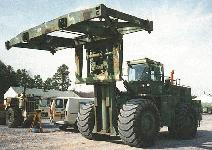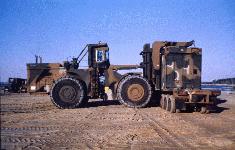




The Army Standard 50K Rough Terrain Container Handler (RTCH), a nondevelopmental item that is a military unique integration of commercial components, is a modified commercial truck which is essentially a Caterpillar model 988B wheel loader with a CAT model AH60 (60,000 lb. Capacity) forklift mast. It is used in conjunction with 20 ft., 35 ft., or 40 ft. top handler attachments for lifting 8 ft. wide containers weighing up to 25 short tons. In its standard configuration, the RTCH can stack containers two high. It is designed to function over rough terrain and through salt water up to 60 inches. Its primary use is in holding and marshalling areas by selected supply, ammunition and transportation units.SSNs, LINs and NSNs for the RTCH and top handler attachments are:
EQUIPMENT SSN LIN NSN RTCH M412 T48941 3930-01-082-3758 20 FT TOP HANDLER R133 T67595 3990-01-107-5716 35 FT TOP HANDLER R133 T67663 3990-01-107-5717 40 FT TOP HANDLER R133 T67731 3990-01-107-5718 Production and Fielding:
The 50K RTCH was manufactured for the US Army under MERADCOM administered contract DAAK70-78-C-0204 by Caterpillar Tractor Company of Peoria, Illinois at a unit cost of $159,138. This contract was awarded 28 September 1978. The RTCH was transitioned to TACOM on 8 December 1981. A total of 320 vehicles were produced for the Army and were fielded between late 1981 and early 1985. The top handlers used in conjunction with the RTCH were produced by ROPCO under subcontract to Caterpillar and were fielded concurrently with the RTCH.
Life Expectancy and Age:
An 11 year estimated useful life span was initially forecast for the RTCH. This was revised to 15 years in 1992 based on continued reliability and supportability of the RTCH at that time as well as experience from other rough terrain material handling equipment.Parts Management and Supply Support:
Wholesale parts management is done primarily by the Defense Logistics Agency (DLA) which is responsible for 98% of the NSNs applicable to the RTCH.
The RTCH is enrolled in the DLA Weapon System Support Program (WSSP) and is assigned the WSSP Code "FPA".
Most parts for this vehicle are available commercially and are routinely purchased by units from local vendors. Some units have indicated that they procure over 90% of the RTCH parts they need locally.
Repair and Maintenance:
Like other Army MHE, all RTCH repair and maintenance is routinely done below depot level.Non-Standard RTCH variants:
There are two known non-standard variants of the RTCH. The first results from the installation of a fork kit that was issued only to Ft.. Eustis concurrent with the initial fielding of the RTCH. So equipped, the RTCH can function as a 50K rough terrain forklift. Only Ft.. Eustis is believed to have ever had RTCHs modified in this way. This fork kit is not currently available in the Army supply system.
The second RTCH variant comes from installing a low mount fork assembly that allows the RTCH to lift half height (4'3") containers. A contract for the low mount fork assembly was awarded to Caterpillar on 12 March 1992 by Volpe National Transportation System Center. Sixty-two kits were fielded between April and September 1992. Ft.. Eustis has about half of all those produced. This half height kit was not provisioned or assigned an NSN and is not available through the Army supply system.Other Service and non-standard CAT RTCHs:
The Air Force procured three RTCHs as an option to the original Army contract with Caterpillar for use with the Containerized Ammunition Distribution System (CADS) shipments, and the Marine Corps purchased 21. The Marines increased their quantity to a total of 106 by awarding a contract for additional RTCHs that were fielded in FY 88. This second procurement was for RTCHs that are basically, but not exactly, like the Army version. In FY 89 the Air Force procured and fielded nine additional vehicles. Most of the Air Force RTCHs were fielded to Japan.
On 20 March 1997, TACOM exercised an option on DLA contract SP0730-96-D-9029 to purchase RTCHs based on the CAT model 988F wheel loader. Twenty-five of these vehicles with an equal number of 40 ft. top handlers and 18 20 ft. top handlers were procured for FORSCOM TDA and AMC requirements. This fielding of these were to displace an equal number of the older standard CAT vehicles which would be sent through the contractor refurbishment program and redistributed to fill TO&E shortages. The 988F RTCH, NSN: 3930-01-449-3178, is not type classified standard and does not enjoy centralized Army management or support.The original US basis of issue was:
Terminal Service Co.: 10ea
Terminal Transfer Co.: 6ea
Conventional Ammo Co.: 3ea
General Supply Co.: 2ea
Repair Parts Co.: 1ea
Heavy Materiel Co.: 1eaThe fielding strategy for the associated top handlers was:
20 ft. - 1 per RTCH truck
35 ft. - 0 per Conventional Ammo Co.; 3 per Terminal Transfer Co.; 1 per RTCH truck for all other units.
40 ft. - Same as for 35 ft.
DISTRIBUTION (selected MACOMs):
| MACOM | Authorized | On Hand (OH) | Net Position |
|---|---|---|---|
| AMC | 136 | 56 | -80 |
| ARMY NG | 4 | 16 | +12 |
| EUSA | 4 | 0 | -4 |
| FORSCOM | 94 | 93 | -1 |
| SPEC OP CMD | 0 | 0 | 0 |
| TRADOC | 10 | 6 | -4 |
| EUROPE | 2 | 2 | 0 |
| PACIFIC | 10 | 1 | -9 |
| RESERVE | 161 | 91 | -70 |
Authorization and on hand data from TAV - June 1998
| 1997 | 1998 | 1999 | 2000 | 2001 | 2002 | 2003 | 2004 | 2005 | 2006 | |
|---|---|---|---|---|---|---|---|---|---|---|
| Beginning Assets | 286 | 286 | 308 | 305 | 301 | 371 | 446 | 521 | 595 | 668 |
| Gains
|
0 | 25 | 0 | 0 | 74 | 80 | 80 | 80 | 80 | 0 |
| Losses
|
0 | 3 | 3 | 4 | 4 | 5 | 5 | 6 | 7 | 7 |
| End FY Assets | 286 | 308 | 305 | 301 | 371 | 446 | 521 | 595 | 668 | 661 |
| Net Position to AAO | -385 | -363 | -366 | -370 | -300 | -225 | -150 | -76 | -3 | -10 |
| Over Age End FY | 49 | 62 | 112 | 119 | 116 | 112 | 108 | 103 | 97 | 92 |

